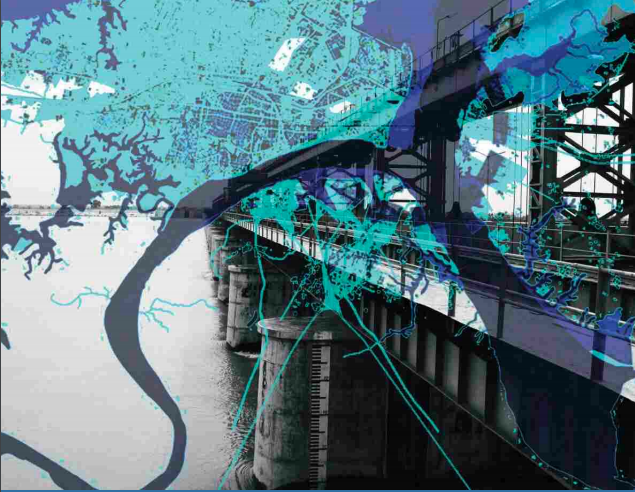Mapping the River Ganga

In addition to lectures, panel discussions, policy workshops and webinars on water, the Columbia Global Centers | Mumbai designed a flagship program focused on the River Ganga to encourage new approaches for the planning and management of river basins. The Ganga is one of the most densely populated river basins in the world and home to almost one-third of India’s people who rely on it for their lives and livelihoods. The river’s fertile alluvial basin, although situated largely within India, also extends into Bangladesh, Nepal, and China. Its unique topography, scale, and challenges offer new perspectives on understanding rivers globally.
Generously supported by the Ford Foundation and the Aditya Birla Group, the Center organized a multi-media exhibition,The River Ganga: India’s Iconic Water Machine with Anthony Acciavatti, Adjunct Assistant Professor, Graduate School of Architecture, Planning and Preservation, Columbia University, and Professor Upmanu Lall, Director of the Columbia Water Center. The exhibition drew upon Dr. Acciavatti’s decade-long research and field materials to present a visual archive and the first systematic study and comprehensive mapping of the infrastructural transformation of the Ganga River Basin.
In Mumbai, the exhibition was inaugurated in August 2017 at the Nehru Science Centre by Rajashree Birla, Director, Aditya Birla Group of Companies and a greatly valued member of the Center’s Advisory Board. It was subsequently co-hosted by the American Center New Delhi from and the National Institute of Hydrology in Roorkee in April 2018.
The exhibition, designed to reflect the shape of a river, took visitors through a visual journey of the descent of the Ganga from the Gangotri glacier in Gaumukh. The maps illustrated the rhythmic shifts of the river and its tributaries based on the cyclical shifts of the monsoon, while transects and photographs showed the penetration of technology – canals, tubewells, and barrages – and how it has been used and abused to extract water for agriculture and drinking purposes.
The exhibition was complemented by a series of panel discussions, workshops and trainings that oriented participants to the environmental heritage of the Ganga, the conflicts of human and environmental ecosystems and climatic shifts in the river basin. To introduce the next generation of professionals to newer research methodologies and contemporary global debates on water management, the Center organized numerous guided walkthroughs and expert interactions. Leading academic institutions, including the Tata Institute of Social Sciences, SVKM’s NMIMS School of Design, the Gateway School of Mumbai and Cathedral and John Connon School, participated. The objective was to reinforce the value of rigorous research and to inspire students to think beyond their taught curriculum. Many noted learning new things about the river including, for example, that it is has the world’s longest canal.